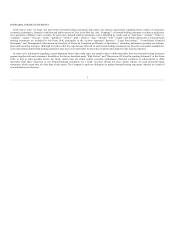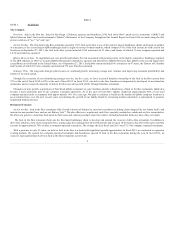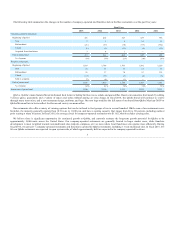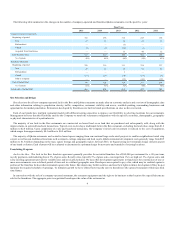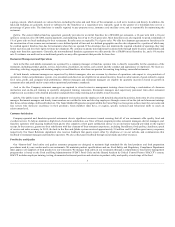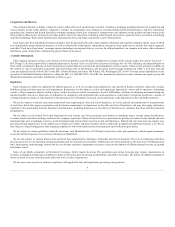Jack In The Box 2015 Annual Report Download - page 13
Download and view the complete annual report
Please find page 13 of the 2015 Jack In The Box annual report below. You can navigate through the pages in the report by either clicking on the pages listed below, or by using the keyword search tool below to find specific information within the annual report.
increases to our customers as a result of adverse economic conditions, competitive pricing or other factors. Therefore, variability of food and other
commodity costs could adversely affect our profitability and results of operations.
A significant number of our Jack in the Box and Qdoba restaurants are company-operated, so we continue to have exposure to operating cost issues.
Exposure to these fluctuating costs, including increases in commodity costs, could negatively impact our margins as well as franchisee margins and
franchisee financial health.
Risk Related to Our Brands and Reputation. Multi-unit food service businesses such as ours can be materially and adversely affected by widespread
negative publicity of any type, particularly regarding food quality, food safety, nutritional content, safety or public health issues (such as epidemics or the
prospect of a pandemic), obesity or other health concerns, and employee relations issues, among other things. Adverse publicity in these areas could damage
the trust customers place in our brands. The increasingly widespread use of mobile communications and social media applications has amplified the speed
and scope of adverse publicity and could hamper our ability to promptly correct misrepresentations or otherwise respond effectively to negative publicity.
We have put in place HACCP-based and Food Safety Management programs to minimize the risk of food safety issues arising in our restaurants and at our
vendors. Nevertheless, food safety risks cannot be completely eliminated. Any outbreak of illness attributed to company or franchised restaurants, or within
the food service industry, or any widespread negative publicity regarding our brands or the restaurant industry in general could cause a decline in our
company and our franchisees’ restaurant sales, and could have a material adverse effect on our financial condition and results of operations.
In addition, the success of our business strategy depends on the value and relevance of our brands and reputation, including implementation and success
of brand strategies. If customers perceive that we and our franchisees fail to deliver a consistently positive and relevant experience, our brands could suffer.
This could have an adverse effect on our business. Moreover, while we devote considerable efforts and resources to protecting our trademarks and other
intellectual property, if these efforts are not successful, the value of our brands may be harmed. This could also have a material adverse effect on our business.
Supply and Distribution Risks. Dependence on frequent deliveries of fresh produce and other food products subjects food service businesses such as ours
to the risk that shortages or interruptions in supply could adversely affect the availability, quality or cost of ingredients or require us to incur additional costs
to obtain adequate supplies. Deliveries of supplies may be affected by adverse weather conditions, natural disasters, distributor or supplier financial or
solvency issues, product recalls, or other issues. Further, increases in fuel prices could result in increased distribution costs. In addition, if any of our
distributors, suppliers, vendors or other contractors fail to meet our quality standards or otherwise do not perform adequately, or if any one or more of such
entities seeks to terminate its agreement or fails to perform as anticipated, or if there is any disruption in any of our distribution or supply relationships or
operations for any reason, our business, financial condition and results of operations may be materially affected.
Risks Associated with Severe Weather and Natural Disasters. Food service businesses such as ours can be materially and adversely affected by severe
weather conditions, such as severe storms, hurricanes, flooding, prolonged drought or protracted heat or cold waves, and natural disasters, such as earthquakes
and wild fires, and their aftermath. Any of these can result in:
• lost restaurant sales when consumers stay home or are physically prevented from reaching the restaurants;
• property damage, loss of product, and resulting lost sales when locations are forced to close for extended periods of time;
• interruptions in supply when distributors or vendors suffer damages or transportation is negatively affected; and
• increased costs if agricultural capacity is diminished or if insurance recoveries do not cover all of our losses.
If systemic or widespread adverse changes in climate or weather patterns occur, we could experience more of these losses, and such losses could have a
material adverse effect on our results of operations and financial condition.
Growth and Development Risks. We intend to grow both Qdoba and Jack in the Box by developing additional company-owned restaurants and through
new restaurant development by franchisees, both in existing markets and in new markets. Development involves substantial risks, including the risk of:
• the inability to identify suitable franchisees;
• limited availability of financing for the Company and for franchisees at acceptable rates and terms;
• development costs exceeding budgeted or contracted amounts;
• delays in completion of construction;
• the inability to identify, or the unavailability of suitable sites at acceptable cost and other leasing or purchase terms;
• developed properties not achieving desired revenue or cash flow levels once opened;
• the negative impact of a new restaurant upon sales at nearby existing restaurants;
• the challenge of developing in areas where competitors are more established or have greater penetration or access to suitable development sites;
• incurring substantial unrecoverable costs in the event a development project is abandoned prior to completion;
11


